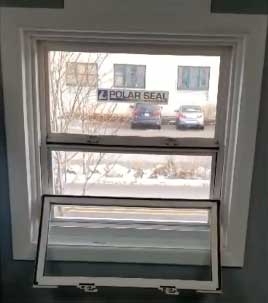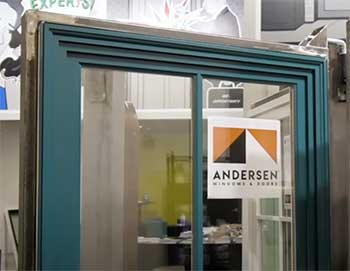If you’re in the market for new windows, you’ve probably come across two big names: Polar Seal and Andersen. Both companies have been around for decades and are known for making high-quality windows. But which one is right for your home and budget?
In this guide, we’ll compare Polar Seal and Andersen windows across a few key factors: performance, materials, cost, warranties, and more. By the end, you’ll have a clear sense of their main differences and which brand may be a better fit for your next window replacement project.
A Brief Comparison Table
| Feature | Polar Seal | Andersen |
| Window Performance | Excellent, specialized in maximum energy efficiency with triple pane insulation | Excellent, highly energy efficient windows |
| Glass & Frame Materials | Vinyl, fiberglass, triple low-E coatings, krypton gas | Vinyl, fiberglass, wood, composite, Low-E4® glass |
| Cost | $300 – $800 installed, similar to Andersen | $400 – $1,000 installed, similar to Polar Seal |
| Warranties | Lifetime on materials, 10 years on glass | 10-20 years on glass and components |
| Aesthetics | 14 exterior colors, modern narrow frames | 40+ exterior colors, traditional wood options |
| Customer Reviews | Extremely positive at 4.5 stars+ | Positive at 4 stars |
Differences Between Polar Seal And Andersen Windows
Window Performance
A window’s performance comes down to a few key metrics:
- U-factor – This measures how well a window insulates against heat transfer. The lower the U-factor, the better the insulation.
- Solar heat gain coefficient (SHGC) – This gauges how well a window blocks heat from sunlight. A lower SHGC helps keep your home cooler.
- Visible light transmittance – This is how much light comes through the glass. Higher visibility is better for natural light.
- Air infiltration – This tests how much outside air leaks through a closed window, which affects energy efficiency. Lower air infiltration is better.
So how do Polar Seal and Andersen compare on these performance metrics?
Overall, both brands offer very efficient window technology. Their highest-tier window lines have excellent U-factors around 0.20-0.22 and SHGCs of 0.20-0.30. Visible light transmittance also reaches up to 0.60+ for crisp clarity.
However, Polar Seal in particular specializes in extreme energy efficiency. Their triple pane windows can achieve U-factors as low as 0.14 and SHGCs down to 0.19. This can make a significant difference for heating and cooling costs.
Both companies also use precision welding and top-notch weatherstripping to limit air infiltration. But slight design differences give Polar Seal windows the edge for a tighter seal once closed.
Performance winner: Polar Seal
Glass & Frame Materials

The materials used in the glass and frame play a big role in window quality.
For glass, most modern windows use double or triple panes with argon/krypton gas fill and low-emissivity (low-E) coatings.
Andersen has its own high-tech low-E coating called Low-E4®.
Polar Seal counters with triple silver low-E coatings and krypton gas for even better insulation.
Frame materials include:
- Vinyl – Most affordable option, good insulation, low maintenance
- Fiberglass – More durable than vinyl, similar insulation
- Wood – Beautiful natural appeal but needs frequent staining/sealing
- Wood-clad – Outer wood look with inner vinyl/fiberglass insulation
- Aluminum – Sleek modern look but conducts more heat/cold
Andersen offers all frame types except aluminum. Polar Seal focuses on vinyl and fiberglass only. Both brands tout vinyl compounds formulated for strength and durability.
There are some minor differences, but overall Andersen and Polar Seal utilize many of the same high-end materials in their window construction.
Materials winner: Draw
Cost Comparison
Another major factor is cost. Window pricing depends on your specific project details, but in general:
Polar Seal windows range from roughly $300 – $800 per window installed. Their lowest-cost Essentials vinyl series starts around $300. The mid-grade Elements fiberglass line is $450-500 installed. And the highest-end Estate triple pane, fiberglass line runs $700-800.
Andersen windows fall within the $400 – $1000 installed range, similar to Polar Seal. Their most affordable 100 Series vinyl windows start around $400. The mid-range 400 Series with fiberglass run $550-650. And the high-end A-Series wood windows hit the $800 to $1,000 mark.
Both brands offer 0% financing specials if you qualify. And you may be able to get a discount of 10-20% off typical prices.
Overall, the pricing is quite similar between Polar Seal and Andersen when comparing products of the same material and features. Either brand can fit well into a variety of budgets.
Cost winner: Draw
Warranties
The warranty terms give a good indication of how long a window will last. More coverage indicates the manufacturer is confident in their quality.
Here’s how the warranties compare:
Polar Seal
- Lifetime warranty on vinyl and fiberglass components
- 10 years on triple pane glass units
- 1 year on moving parts and screens
Andersen
- 20 years on glass seal failure
- 10 years on certain hardware components
- 2 years on manufacturing defects
- 10 years prorated on vinyl parts
The materials coverage from Polar Seal is clearly longer versus the prorated vinyl warranty from Andersen. Polar Seal also provides an impressive 10 years on all triple pane units.
However, Andersen does back specific parts like hardware and seals for longer terms in their warranty.
Overall Polar Seal edges out Andersen for more comprehensive lifetime materials coverage, but Andersen isn’t too far behind.
Warranties winner: Polar Seal
Aesthetics
Beyond just performance, you want windows that enhance your home’s aesthetics. This includes:
- Styles – Double/single hung, casement, awning, sliding, etc.
- Frames – Color, shape, and material options
- Hardware – Color coordinated with durable finishes
- Grilles – Simulated divided lite or removable grilles
Both Andersen and Polar Seal offer versatile options to match your home’s style.

Andersen has over 40 exterior color choices from basic white to deeper architectural hues.
They also have a variety of grille patterns and hardware finishes to choose from.
Their wood windows can be stained for a traditional appearance.
Polar Seal windows come in 14 standard exterior shades.
They also offer triple pane options to achieve modern super-slim frame profiles. Their v-groove glass adds dimension without grilles. And hardware comes in sleek satin nickel, white, or black.
There are lots of possibilities with either brand. It comes down to finding the right styles and finishes for your particular home.
Aesthetics winner: Draw
Customer Reviews
Looking at customer feedback is helpful to see real-world experiences with these window brands.
Andersen reviews are generally positive, averaging around 4 stars. Customers praise the attractive aesthetics, solid performance, and professional installation from dealers. Complaints mention issues with condensation in certain climates. There are also some warranty concerns.
Polar Seal reviews are overwhelmingly positive at 4.5+ stars. Owners say the windows transformed their homes with quiet, comfortable insulation. Nearly all reviews cite smooth installations and great customer service from Polar Seal if any concerns arise. Negative feedback is very minimal.
Based on customer satisfaction, Polar Seal windows have a slight edge in reviews over Andersen. But both receive solid ratings overall.
Reviews winner: Polar Seal
Frequently Asked Questions (FAQ)
Yes, Polar Seal windows are known for outstanding quality and energy efficiency. They offer triple pane glass for maximum insulation along with strong vinyl and fiberglass frames. Owners give high praise for Polar Seal’s performance, value, and durability.
Some brands considered comparable in quality and features to Andersen include Pella, Marvin, Milgard, and Jeld-Wen. Polar Seal is also considered on par with Andersen in terms of technology, materials, and reputation.
Three top-performing window seal types are bulb seals, EDPM seals, and thermoplastic vulcanizate (TPV) seals. Bulb seals are the most common using compression to block air. EDPM seals resist temperature changes. And TPV seals like Polar Seal’s FlexSeal are durable, flexible silicone gaskets.
Some competing replacement window companies that offer similar products and services as Renewal by Andersen include Window World, Empire Windows, Window Nation, and Pella Windows.
The Verdict
Overall, Polar Seal just barely edges out Andersen when comparing total performance, cost, warranty, and reviews.
Polar Seal windows excel in energy efficiency and owner satisfaction. Their triple silver low-E coatings and krypton gas earn top marks for insulation. Customers also rave about quality and value from Polar Seal windows.
But Andersen remains a venerable brand and offers competitive window technology. Their Low-E4® glass, Fibrex composite frames, and sleek hardware also have compelling benefits.
You really can’t go wrong with either brand. Make sure to get quotes for your actual project. This will allow you to compare warranties, features, and installed costs side-by-side. That will help determine the better brand for you based on your home, budget, and needs.
With quality windows from Polar Seal or Andersen, you’ll be making a sound investment in comfort and energy savings for years to come.
